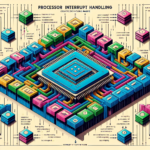The Role of Transistors in CPU Functionality

Introduction
Transistors are the fundamental building blocks of modern electronic devices, particularly in the realm of computing. They play a crucial role in the functionality of Central Processing Units (CPUs), which are the brains of computers. This article delves into the intricate role of transistors in CPU functionality, exploring their history, types, and how they contribute to the overall performance of a CPU.
The Evolution of Transistors
The Birth of the Transistor
The invention of the transistor in 1947 by John Bardeen, Walter Brattain, and William Shockley at Bell Labs marked a revolutionary moment in electronics. Before transistors, vacuum tubes were used in electronic circuits, but they were bulky, consumed a lot of power, and were prone to failure. The advent of the transistor provided a more reliable, smaller, and energy-efficient alternative.
From Discrete Transistors to Integrated Circuits
Initially, transistors were used as discrete components in circuits. However, as technology advanced, the concept of integrating multiple transistors into a single chip emerged. This led to the development of Integrated Circuits (ICs) in the 1960s, which significantly increased the complexity and capability of electronic devices while reducing their size and cost.
Understanding Transistors
What is a Transistor?
A transistor is a semiconductor device used to amplify or switch electronic signals and electrical power. It consists of three layers of semiconductor material, each capable of carrying a current. The three layers form two junctions, and the transistor can be in one of three states: cutoff, active, or saturation.
Types of Transistors
- Bipolar Junction Transistors (BJTs): These transistors have three terminals: the emitter, base, and collector. They are used for amplification and switching and come in two types: NPN and PNP.
- Field-Effect Transistors (FETs): These transistors control the flow of current by applying a voltage to the gate terminal, which creates an electric field. The most common type of FET is the Metal-Oxide-Semiconductor FET (MOSFET), which is widely used in digital circuits.
The Role of Transistors in CPU Functionality
Basic CPU Architecture
A CPU is composed of several key components, including the Arithmetic Logic Unit (ALU), Control Unit (CU), and various registers. Transistors are integral to each of these components, enabling the CPU to perform its functions efficiently.
Transistors in the Arithmetic Logic Unit (ALU)
The ALU is responsible for performing arithmetic and logical operations. Transistors in the ALU are used to create logic gates, which are the building blocks of digital circuits. These logic gates perform basic operations like AND, OR, NOT, and XOR, which are essential for executing instructions.
Transistors in the Control Unit (CU)
The Control Unit directs the operation of the processor by managing the flow of data between the CPU and other components. Transistors in the CU are used to create control logic circuits that generate the necessary signals to coordinate the activities of the CPU.
Transistors in Registers and Memory
Registers are small storage locations within the CPU that hold data temporarily. Transistors are used to create flip-flops, which are bistable devices that can store a single bit of data. These flip-flops are combined to form registers and memory cells, enabling the CPU to store and retrieve data quickly.
Transistor Scaling and Moore’s Law
What is Moore’s Law?
Moore’s Law, proposed by Gordon Moore in 1965, states that the number of transistors on a microchip doubles approximately every two years, leading to an exponential increase in computing power. This prediction has held true for several decades, driving the rapid advancement of CPU technology.
The Challenges of Transistor Scaling
As transistors have become smaller, several challenges have emerged, including:
- Heat Dissipation: Smaller transistors generate more heat, which can affect the performance and reliability of the CPU.
- Leakage Current: As transistors shrink, leakage current becomes a significant issue, leading to increased power consumption and reduced efficiency.
- Manufacturing Complexity: Producing smaller transistors requires advanced manufacturing techniques, which can be costly and complex.
Advanced Transistor Technologies
FinFETs
Fin Field-Effect Transistors (FinFETs) are a type of 3D transistor that addresses some of the challenges of traditional planar transistors. FinFETs have a fin-like structure that allows for better control of the current flow, reducing leakage and improving performance.
Gate-All-Around (GAA) Transistors
Gate-All-Around (GAA) transistors are an emerging technology that further improves upon FinFETs by surrounding the channel with the gate on all sides. This design provides even better control over the current flow, enabling further scaling and performance enhancements.
Future Trends in Transistor Technology
Quantum Computing
Quantum computing represents a significant departure from traditional transistor-based computing. Instead of using transistors, quantum computers use qubits, which can exist in multiple states simultaneously. While still in the experimental stage, quantum computing has the potential to revolutionize computing by solving problems that are currently intractable for classical computers.
Carbon Nanotube Transistors
Carbon nanotube transistors are another promising technology that could replace silicon-based transistors. Carbon nanotubes have excellent electrical properties and can be used to create transistors that are smaller, faster, and more energy-efficient than traditional silicon transistors.
FAQ
What is the primary function of a transistor in a CPU?
The primary function of a transistor in a CPU is to act as a switch or amplifier. Transistors are used to create logic gates, control circuits, and memory cells, enabling the CPU to perform arithmetic and logical operations, manage data flow, and store information.
How many transistors are in a modern CPU?
The number of transistors in a modern CPU varies depending on the specific model and manufacturer. High-end CPUs can contain billions of transistors. For example, as of 2021, AMD’s Ryzen 9 5950X CPU contains approximately 4.15 billion transistors.
Why are smaller transistors better for CPUs?
Smaller transistors are better for CPUs because they allow for more transistors to be packed into a smaller area, increasing the processing power and efficiency of the CPU. Additionally, smaller transistors consume less power and generate less heat, improving the overall performance and reliability of the CPU.
What are the main challenges of transistor scaling?
The main challenges of transistor scaling include heat dissipation, leakage current, and manufacturing complexity. As transistors become smaller, they generate more heat, which can affect performance and reliability. Leakage current also becomes a significant issue, leading to increased power consumption. Additionally, producing smaller transistors requires advanced manufacturing techniques, which can be costly and complex.
What is the future of transistor technology?
The future of transistor technology includes advancements such as FinFETs, Gate-All-Around (GAA) transistors, quantum computing, and carbon nanotube transistors. These technologies aim to address the challenges of traditional silicon-based transistors and enable further scaling and performance enhancements.
Conclusion
Transistors are the cornerstone of modern CPU functionality, enabling the complex operations that drive today’s computing devices. From their invention in the mid-20th century to the advanced technologies being developed today, transistors have continually evolved to meet the demands of increasing computational power and efficiency. As we look to the future, innovations in transistor technology promise to further revolutionize the field of computing, opening up new possibilities and applications.




